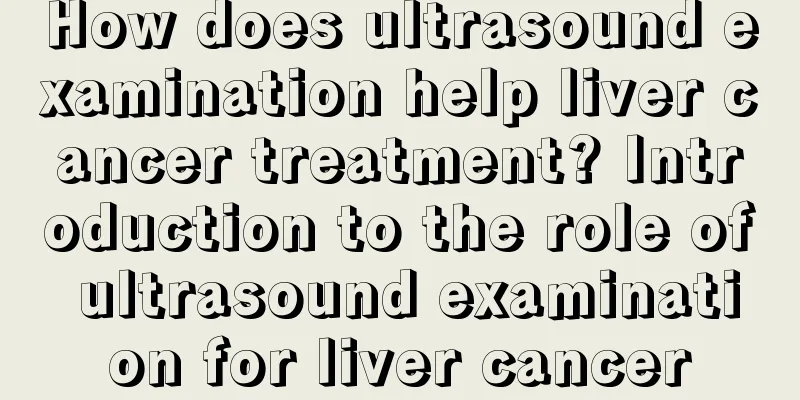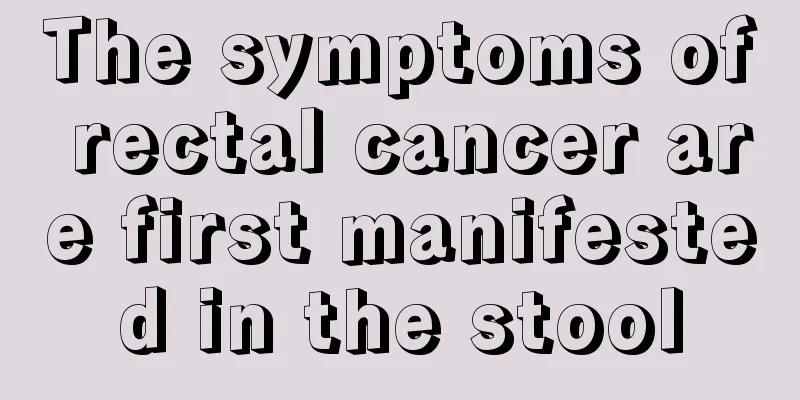How does ultrasound examination help liver cancer treatment? Introduction to the role of ultrasound examination for liver cancer

|
How can ultrasound examination help in the treatment of liver cancer? Among the many imaging examinations, ultrasound is an indispensable and irreplaceable examination item for liver cancer. Next, I want to introduce to you the role of ultrasound examination in liver cancer. Come and have a look. Self-examination methods for liver cancer Experts say that once you experience physical fatigue and pain in the upper right side of your abdomen, you should pay attention and go to the hospital for treatment immediately. If the liver is invaded by cancer cells, the fuel supply of the whole body will be reduced, resulting in lack of heat energy, fatigue and easy exhaustion. If you are just tired or lazy, it may be due to a cold or excessive fatigue. How to self-examine liver cancer is very important. Few people do not realize that they may have liver cancer, so the disease is delayed. If the cancerous tissue is slightly larger, it may cause a dull feeling in the pit of the stomach or a dull pain in the upper right part of the abdomen. Even if it is not painful, there will be a sense of oppression and discomfort. How to self-check for liver cancer? This can be determined from the following points. When suffering from liver cancer, there are often symptoms caused by stomach disorders, including loss of appetite, nausea, fullness after eating, and stomach discomfort. If you lose weight, have unexplained fever from time to time, and develop jaundice, you must go to the hospital for alpha-fetoprotein, B-ultrasound, CT, X-ray hepatic angiography and other methods to confirm the diagnosis. If you experience the above symptoms, you should have an ultrasound examination to understand the condition. The role of ultrasound in liver cancer Ultrasound examination is the most important means of postoperative follow-up and the most commonly used means for early detection and diagnosis of recurrence. It is currently popular in most hospitals in China. As a simple, sensitive, accurate, economical, and non-radioactive non-invasive examination, it is widely used in the early detection and diagnosis of liver cancer. Color Doppler imaging can observe the blood flow distribution inside the lesion, thereby improving the detection rate and qualitative ability of liver cancer. Ultrasound can diagnose HCC lesions with a diameter of about 1 cm, and high-performance ultrasound instruments can even display and identify small HCC recurrence lesions with a diameter of 0.5 cm. In addition to being a common method for diagnosing and differentially diagnosing liver cancer, ultrasound imaging can also show the relative position and anatomical relationship between the lesion and the large blood vessels, whether there is tumor spread to the rest of the liver and hilar lymph node metastasis, and whether there is cancer thrombus formation in the main trunk of the portal vein and its branches. It is of great value in determining the treatment plan and estimating the possibility of resection. Ultrasound contrast imaging, also known as enhanced ultrasound imaging, is based on ordinary ultrasound. Ultrasound contrast agents (a type of gas microbubble agent) are injected intravenously to observe the blood perfusion and microvascular network distribution of tumors in real time, and to detect the dynamic changes in blood flow in tumor tissues in real time. It is an important new diagnostic method in the field of ultrasound imaging in recent years. Ultrasound contrast agents are highly safe. The main component is gas microbubbles. There is no iodine allergic reaction. A small amount is required each time, and it is still tolerable for patients with heart and kidney failure. Because ultrasound contrast imaging can observe the blood perfusion of the lesion and the liver parenchyma in real time and the whole process of withdrawal, it can better distinguish the various phases of liver blood perfusion, which helps to more accurately judge the blood supply characteristics of the lesion. Qualitative diagnosis of liver space-occupying lesions can be made more accurately. It will play a greater role in the early diagnosis and differential diagnosis of HCC, especially in helping to determine the thoroughness of local treatments such as radiofrequency ablation (RFA) and intratumoral anhydrous alcohol injection (pEI), and local tumor recurrence. Ultrasound examination has the advantages of being economical, convenient, repeatable, non-invasive, and non-radioactive. It can basically reflect the image characteristics of HCC lesions and can be used as the preferred imaging diagnostic method for high-risk patient surveys and postoperative follow-up screening. However, the results of ultrasound examinations are easily limited by the experience of the examiner. Smaller tumors located at higher positions on the top of the liver diaphragm and farther away from the left lateral lobe are easily missed, and the detection rate of lesions with a diameter of less than 1 cm is low. Therefore, other imaging methods should be combined to improve diagnostic sensitivity and accuracy. From this point of view, ultrasound examination of liver cancer is very necessary. |
>>: What are the treatments for lung cancer? Check out the 5 common treatments for lung cancer
Recommend
What are the benefits of chalcedony to the human body
Compared with gold, many elderly people prefer to...
How much does it cost to treat breast cancer bone metastasis
How much does it cost to treat bone metastasis of...
Is amenorrhea a symptom of cervical cancer?
Is amenorrhea a symptom of cervical cancer? 1. Am...
What is the function of potassium permanganate?
When we studied chemistry in junior high school, ...
Does nasopharyngeal cancer cause tinnitus? What are the early symptoms?
Does nasopharyngeal cancer cause tinnitus? What a...
What foods are better for esophageal cancer
If you suffer from esophageal cancer in your life...
The harm of red potatoes
There are many varieties of potatoes, such as red...
What is the difference between rambutan and lychee?
When the concubine in the world of mortals smiled...
How to quickly remove dirt by taking a shower?
People do a lot of things every day, and their sk...
What causes Meibomian gland blockage?
Meibomian gland blockage is a disease that many y...
How much does it cost to treat lymphoma
Lymphoma is one of the serious malignant tumors. ...
The best way to conceive with a retroverted uterus
Retroverted uterus is a common position of the ut...
What causes frequent nosebleeds
Nosebleed can be said to be a symptom, and many d...
Unsteady walking, dizziness, body shaking
Walking is something we need to do every day. We ...
Nephrotic syndrome includes_Nephrotic syndrome means_What is nephrotic syndrome
Kidney is a very important organ in our body, bec...









